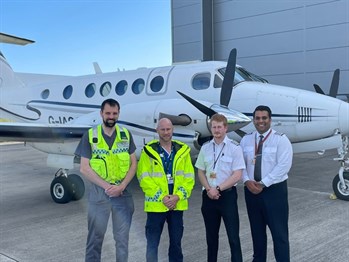The Isle of Man Air Ambulance Service gives people on the Isle of Man access to specialist healthcare in the UK, when they are too unwell to travel on Loganair or the Steam Packet.

It has been in operation for over 20 years, and can operate 24 hours a day, 365 days a year (when needed), although most transfers take place during the daytime.
The service (which is organised out of Noble’s Hospital) has a contracted aeroplane exclusively for their use, based in a hangar at Ronaldsway. They use the plane for the majority of transfers, but when a patient is unable to fly in this plane they use the Coastguard Search and Rescue helicopter, which is based in Caenarfon, Wales. The team provides a very reliable service
Dr. Kate Teare, Consultant Anaesthetist and Medical Lead with the Isle of Man Air Ambulance Service, said:
'In the decade I’ve been involved, we haven’t turned down a patient who needed transfer.'
The service is funded by Manx Care, but sometimes receives kind donations from patients or their family members, for which the team is very grateful.
Who are the patients
The IOM Air Ambulance Service completed 549 patient journeys between April 2023 and April 2024 – you can see a general breakdown of specialties below:
Around half of patients are travelling for heart services (mainly for interventions like stents to open up the blood supply to the heart muscle, or for pacemakers).
Other larger groups are those travelling for cancer services like radiotherapy (usually at Clatterbridge), trauma patients (i.e. broken bones and other injuries like ruptured spleens), and those for brain or spinal surgery services. Children and babies make up the fifth largest group.
Who staffs the Isle of Man Air Ambulance Service
Most of the work is done by Transfer Practitioners, with almost half being Nurses and almost half Paramedics; most of these colleagues have another job within Manx Care. All come to the service with relevant skills, then are trained locally for the additional skills needed. There are three full-time staff, three part-time and another 14 colleagues who do bank shifts.
Less than 10% of the patients need a doctor to go with them, but the service has access to six Anaesthetists and two emergency department Consultants who can accompany critically ill patients. Other specialists fly with the team when needed, including Paediatricians who will travel with babies and young children, Midwives, Children’s Nurses and Special Care Baby Unit Nurses.
In terms of clinical care need, the team sees a very diverse group of patients. Examples range from a person awaiting a kidney transplant being contacted to say a suitable organ is available, just after the Loganair flight has departed – in this case, the team would take them as transport. At the other end of the spectrum are the major trauma patients, for example people who have come off their motorbikes at significant speed, sustaining multiple life-threatening injuries. The team can anaesthetise them at Noble’s, put them on a ventilator, do a blood transfusion during flight, carry chest drains to expand collapsed lungs, provide pain relief and more. Two thirds of the patients who travel out via Air Ambulance will return on Loganair.
TT 2024
During TT 2024, the Isle of Man Air Ambulance Service transferred 24 patients to the UK for specialist treatment. A number were bikers with multiple serious injuries, and some with complex broken bones. They were transferred to the major trauma centre at Aintree Hospital, Liverpool. The remaining patients were mainly local residents who were transferred for a mixture of other reasons, the most common reason being a heart attack.
Dr Teare concluded:
'A major strength of our service lies in its ability to match the right staff, skills and equipment to the situation in a timely manner, for a huge range of patients.'


